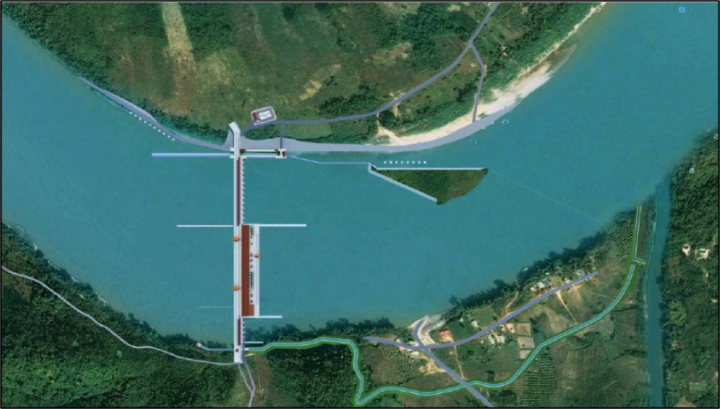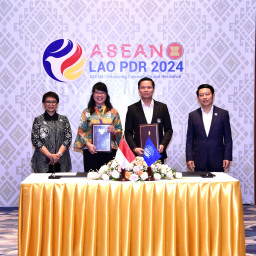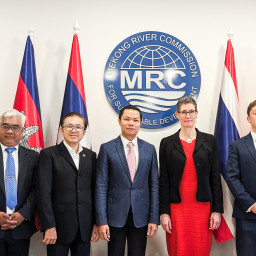Laos to undertake prior consultation for Sanakham hydropower project
Vientiane, Lao PDR, 11 May 2020 — Lao PDR will undertake the Mekong River Commission’s (MRC) prior consultation process for its Sanakham hydropower project, the sixth proposed project on the Mekong mainstream. The run-of-river dam will operate continuously year-round and produce 684 megawatts of electricity.
In its notification submitted to the MRC Secretariat, the Lao Government provided a set of engineering documents and technical feasibility study, including the project’s social and environmental impact assessments and sediment and fisheries study, which will be shared with the other MRC Member Countries—Cambodia, Thailand and Viet Nam.
According to the notification, the project’s construction is expected to begin in 2020 and finish in 2028, the year the commercial operations are also set to begin. The energy generated by the project will mainly be exported to Thailand.
“Laos submitted the project as an intra-basin water use around the year on the mainstream of the Mekong River, which is subject to undergoing the prior consultation process. The submission will enable the notified Member Countries and members of the public to have detailed information and study the project’s water use and any potential impacts stemming from the project,” says Dr An Pich Hatda, CEO of the MRC Secretariat.

A drawing of the proposed Sanakham hydropower project. Courtesy of Datang (Lao) Sanakham Hydropower Co. Ltd.
The prior consultation process is part of the MRC’s procedural rules on water use of the Mekong mainstream: Procedures for Notification, Prior Consultation and Agreement (PNPCA). Under the PNPCA, any infrastructure project using the mainstream water during the dry season within the same basin, as well as during the wet season between two basins, must undergo the prior consultation process. Applicable projects include large-scale irrigation and hydropower development which may cause significant impacts on the environment, water flow and quality of the Mekong mainstream.
In the prior consultation process, with technical and administrative support from the MRC Secretariat, the MRC’s governing body Joint Committee will review technical aspects of the project, assess any potential transboundary impacts on the environment and livelihoods along the riparian communities, and suggest measures to address those concerns. The Joint Committee aims to reach an agreement on the proposed use and to issue a decision that contains agreed upon conditions. That decision will become part of the record of the proposed use and the use of the waters when commenced.
The prior consultation process normally lasts six months but could be extended further by the Joint Committee. It is not meant to approve or disapprove the proposed project.
According to the MRC, the Lao Government submitted the Sanakham for prior consultation on 9 September 2019, shortly after its submission of the Luang Prabang project. But to ensure a meaningful consultation process, the Joint Committee decided to hold the consultation for Sanakham only after Luang Prabang.
Based on MRC procedures, after the submission, the MRC Secretariat has to review and verify the completeness of the submitted documents. With the technical review for the Luang Prabang prior consultation completed, the Secretariat has now completed the initial document verification of the Sannakham project and forwarded all the submitted documents to the other three notified countries for their review. These documents are now available on the MRC website for public access.
The prior consultation process for the Luang Prabang project began on 8 October 2019 and scheduled to end on 7 April 2020. But due to the Covid-19 pandemic, the Joint Committee was unable to meet yet to agree on the Joint Statement and Joint Action Plan. The next scheduled meeting is 4 June 2020.
Until now, 49 projects on the Mekong tributaries have been submitted for the Notification process under the PNPCA: three projects from Cambodia, 30 from Lao PDR, two from Thailand and 14 from Viet Nam. In addition to the Sanakham submission, five other projects including the Xayaburi, Don Sahong, Pak Beng, Pak Lay and Luang Prabang have so far been proposed on the Mekong mainstream and thus submitted for the prior consultation process.

Map of the Mekong River Basin showing Mekong mainstream dams
Located between Xayaburi and Vientiane provinces of Lao PDR, the Sanakham project is about 2 km upstream of the Thai-Lao border of Loei province and approximately 1,737 km from the sea. It lies about 25 km upstream from Sanakham district of Vientiane province, about 155 km from Vientiane capital at downstream, and about 84 km downstream of the Pak Lay project.
The powerhouse is about 350 m long and 58 m high, and has 12 turbines, each producing 57 MW.
According to the submitted documents, Datang (Lao) Sanakham Hydropower Co. Ltd is listed as the project developer. The total cost of the project is estimated at US$ 2,073 million. Of these, about US$ 27.7 million is allocated for environmental and social mitigation measures and monitoring programmes.
The MRC Joint Committee Working Group (JCWG), whose members comprise senior technical representatives from Cambodia, Lao PDR, Thailand and Viet Nam and who acts as an advisory body to the MRC’s Joint Committee in implementing the PNPCA, is scheduled to meet on 16 June 2020 to discuss key issues around the prior consultation process of the project, including the starting date of the six-month process.
The MRC together with the National Mekong Committee Secretariats will facilitate national and regional consultations to solicit the public views on the case.
Read this news in Khmer, Lao, Thai or Vietnamese.
Note to editors:
The Mekong River Commission is an intergovernmental organization for regional dialogue and cooperation in the lower Mekong river basin, established in 1995 based on the Mekong Agreement between Cambodia, Lao PDR, Thailand and Viet Nam. The organization serves as a regional platform for water diplomacy as well as a knowledge hub of water resources management for the sustainable development of the region.
-END-
###





